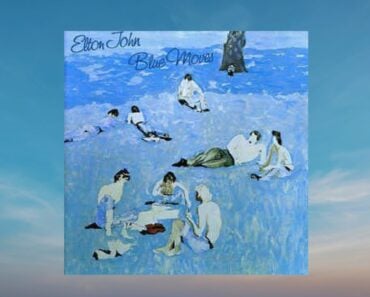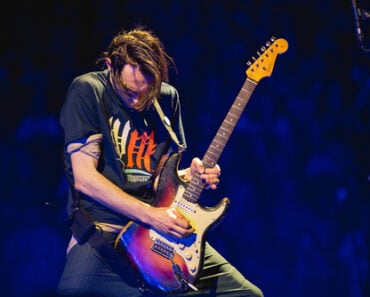
Photo: Low Res Creative Commons-Fair Use for review purposes
Robert Plant’s career has spanned over fifty years during which he has established himself as one of the most highly regarded frontmen of all time, amassing millions of album sales, directing multiple musical projects, and even being honored with the title of Commander of the Order of the British Empire by Queen Elizabeth II in 2009. His timeless body of work with musical colossus Led Zeppelin has served as a point of reference for countless artists within all genres, and his stage-presentation as the bare-chested, dynamic, howling frontman has served as the blueprint for the archetypical rock and metal singer.
In their twelve brief years of activity,Led Zeppelin appeared to have scaled every mountain, conquered every obstacle, and made every necessary statement of musical intent before dismantling the entire enterprise following the death of drummer John Bonham at just 32 years old. How then, is an artist expected to proceed in the face of such intense associations with an act which garnered immense degrees of commercial success and cultural influence that would span generations? That answer is contingent upon the recipient of the inquiry, as the remaining members of Led Zeppelin would each take their own approach to life after the band.
Bassist John Paul Jones characteristically retreated from the public eye for some time to be with his family. Jimmy Page – a central figurehead of the band’s image – continued to play and record in various capacities, never forming a stable band or establishing himself as a true solo act. Despite some trepidation initially, Robert Plant was the first member of the defunct group to make the leap into solo territory, recording and releasing the first album under his own name: 1982’s Pictures at Eleven.
Even prior to the untimely passing of John Bonham, Led Zeppelin were very much struggling to maintain a unified front. The 1978 sessions for In Through the Out Door saw discrepancies in the members’ creative contributions, with Plant and Jones dictating much of the album’s creative direction as Page and Bonham, each struggling with their own substance abuse issues, could seldom be depended upon to make timely or productive appearances for the recording sessions. Consequently, 1980’s In Through the Out Door is perhaps the most creatively lopsided entry in the band’s discography, with much of the album’s sound reflecting the pop influences which would eventually color Robert Plant’s solo work, as well Jones’ exploration of electronic keyboards.
One prominent example of the Plant/Jones dynamic at play is the elaborate, progressive-leaning “Carouselambra” which opens side two of the album and is, with its 10:28 runtime, the second-longest track that Led Zeppelin ever recorded in the studio, with only “In My Time of Dying” from 1975’s Physical Graffiti boasting a longer runtime at 11:04. But perhaps the most enduring testament to the band’s altered dynamic in regard to the creative process is the Plant/Jones composition “All My Love,” a synthesizer-driven ballad with a sing-along chorus which apparently drew the ire of Jimmy Page and John Bonham who were more hesitant the move away from the rock and blues sound for which the band were best known.
Despite the creative tensions and personal issues which would manifest throughout the recording sessions, In Through the Out Door was released in 1979 to mixed reactions from listeners and critics alike. The band then set out on a brief European tour in preparation for their upcoming North American tour, the first the band would undertake in the area since 1977. It was not to be, however, as John Bonham collapsed onstage during the first show of the European tour, resulting in its cancellation, and would soon pass away following a rehearsal for the North American tour. Uncertain of how or if the band intended to move forward, speculation began to rise concerning potential replacement drummers for Bonham. Among those suggested were Carmine Appice and Cozy Powell (who would go on to work with Plant on Pictures at Eleven,) though it was soon announced by the band that Led Zeppelin simply could not continue without John Bonham.
Upon the dissolution of the band, Robert Plant formed a new group known as The Honeydrippers which featured friends and musical acquaintances. The group performed small shows in 1981, but would not release any recorded material until 1984’s The Honeydrippers: Volume One by which time Jimmy Page and Jeff Beck were handling guitar duties within the band. The original lineup, however, featured a young guitarist named Robbie Blunt with whom Robert Plant would strike up a musical rapport, leading to Blunt’s installation as lead guitarist for Robert Plant’s solo band for which he would record on Plant’s first three solo albums before his departure in 1985.
It was at this time that a key character in the narrative would present himself, and that character was Phil Collins. The legendary Genesis drummer was engrossed in multiple projects at the time – a pace he would maintain throughout much of the 1980s – having just recently taken over lead vocal duties in Genesis while maintaining his duties on drums, played drums on the recently-departed Peter Gabriel’s third album, and crafted his own solo album on which he performed nearly all the instrumental and vocal tracks himself, he was about to carve out yet another opportunity for himself as Robert Plant’s drummer.
Driven by his own affinity for the drumming of John Bonham, Collins drove Robert Plant to press on with his career, despite Robert Plant’s trepidation in the face of his former band’s dissolution and was highly enthusiastic throughout the entire process. The pair’s working relationship would span over a number of years and would see Collins contributing drums to Robert Plant’s next solo album, 1983’s The Principal Moments, as well as sitting in on drums for the much-maligned Led Zeppelin reunion performance during 1985’s Live Aid benefit concert.
Musically, Pictures at Eleven maintains the general air of Robert Plant’s work with Led Zeppelin, in that it is characterized by what it is that Robert Plant brings to the table creatively, both as a band member and solo artist. Robert Plant has acknowledged his own cognizance of Led Zeppelin’s immense stature and the reverence reserved for them by the record-buying public at the time, as well as the general understanding that their output could not be effectively replicated or bested. As such, he has stated that he intentionally pushed his own music away from the direction of his former band. However, some things are simply inevitable, and given that Led Zeppelin was 25% Robert Plant, there is no way to avoid hints of a Led Zeppelin sound on a record that is 100% Robert Plant.
There is a noticeably subdued element within Led Zeppelin’s rock-oriented material. The drums are heavy, and the riffs are dynamic and dramatic, but there’s meticulousness to them despite their inherently perfunctory application. One can hear that the band isn’t laying on the gas completely because they know they don’t need to. One might equate the approach to the plodding advance of an indomitable monster such as Michael Myers or Jason Voorhees in a classic horror film. Even during their most unabashed rockers such as “Immigrant Song” or “Out on the Tiles,” the band always made the execution sound utterly effortless. They tended to lie back on the bass and drums to ride the groove, increasing the heaviness of the records.
The absence of Jimmy Page notwithstanding, that feeling manages to carry over much of the time to Pictures At Eleven and is apparent from the offset with the dense attack of opening number “Burning Down One Side” marking the public’s introduction to Robbie Blunt who, to his credit, makes the most of a tough situation. The simultaneous elation and horror that would undoubtedly accompany the request to fill the shoes of Jimmy Page in 1981 would be enough to make a lesser musician crumble into their own pedalboard. But Blunt makes impressive work of bringing a unique flavor to the record while honoring underlying expectations, as well as serving each song in the best possible way he is able.
There exists a subtlety within Blunt’s playing that might leave the average Led Zeppelin aficionado pining for the good old days, but that’s the cost of listening with specific expectations. Pictures At Eleven was, very much by design, not built to be a Led Zeppelin record, and there are many moments throughout the album that benefit from that very quality. The most glaring omission, however, is that of drummer John Bonham. Phil Collins does a serviceable job holding down the time, but his efforts often seem frail and flimsy in comparison to Bonzo’s full, bombastic attack behind the kit, an issue that is only exacerbated by the thin, early 80s production which has dated substantially over the years.
Slow-burners like the Spanish-imbued “Moonlight in Samosa” and “Like I’ve Never Been Gone” – the latter track being one of only songs on the album not to feature Collins, as Rainbow’s Cozy Powell steps in on drum duties – provide insight as to which Led Zeppelin tracks may have originated with Plant, as tracks like these aren’t that far off from the “Rain Song” style ballads within the Led Zeppelin canon. “Like I’ve Never Been Gone” specifically is reminiscent of the more ambitious Led Zeppelin arrangements such as “No Quarter” and “Stairway to Heaven.” However, the most interesting moments throughout the album occur when it veers a bit left musically.
Album standout “Fat Lip” makes an excellent case for the recruitment of Robbie Blunt, as his middle eastern tinged fretwork atop a loop of Phil Collins’ insistent, skeletal drum track creates a tension which continually rises and falls, never truly resolving itself as the track eventually fades to silence. Despite some clear stylistic departures, Pictures At Eleven has groove and attitude to spare as evidenced by moments like “Worse Than Detroit,” “Mystery Title,” and “Pledge Pin,” which features a raucous saxophone solo by “Baker Street” saxophonist Raphael Ravenscroft.
Upon its release in 1982, as could be expected, Pictures at Eleven failed to make the commercial or critical impact of a Led Zeppelin project, but was moderately successful despite Robert Plantt’s resolve not to tour in promotion of the album. Robert Plant would continue to write and record new music, and ultimately would establish a successful solo career. The remaining members of Led Zeppelin would reunite intermittently and in varying capacities over the course of the ensuing decades, participating in various projects such as the Page and Plant duo project and the aforementioned Honeydrippers, as well as giving the occasional live performance, perhaps the most notable being their 2007 performance at The O2 Arena in London for the Ahmet Ertegun Tribute Concert which featured Jason Bonham filling in for his father on drums. This performance was released in 2012 as the concert film Celebration Day.
The members of Led Zeppelin effectively painted themselves in a corner during the early stages of their respective careers and have spent the ensuing years operating in the indelible shadow cast by the ubiquity of their work as a band. While the whole may be more than the sum of its parts, the remaining members of Led Zeppelin each still had their own worthwhile musical contributions to make, contributions which can be heard throughout the breadth of material which has been released since 1980. Robert Plant in particular has forged a path as a solo artist that would be the envy of many a musician, with or without his credentials of having fronted the mightiest band of rock history.
Pictures at Eleven is a testament to the ability and resolve of a man seemingly with both nothing and everything to lose. There was no sea changing coming on the heels of Pictures at Eleven, nor was there ever intended to be one. If the end goal was, as it can be assumed to be, to exercise his distinct creative instinct in a way which would remind listeners why he was one of the best to ever do it, the excursion upon which Robert Plant set out with Pictures at Eleven appears to have been a patented success.
Pictures at Eleven: A Look Back at Robert Plant’s Solo Debut LP article published on Classic RockHistory.com© 2021
Classicrockhistory.com claims ownership of all its original content and Intellectual property under United States Copyright laws and those of all other foreign countries. No one person, business or any organizations is allowed to republish any of our original content anywhere on the web or in print without our permission.



































